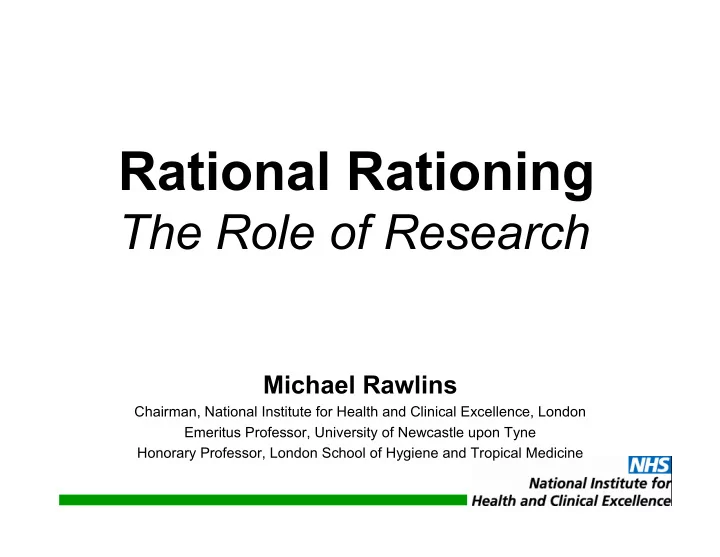

Rational Rationing The Role of Research Michael Rawlins Chairman, National Institute for Health and Clinical Excellence, London Emeritus Professor, University of Newcastle upon Tyne Honorary Professor, London School of Hygiene and Tropical Medicine
Resource Constraints Healthcare Expenditure (US$ per person) 8000 Cost (US$) per person per year 7000 6000 5000 4000 3000 2000 1000 0
GDP and Healthcare Expenditure 2007 7,000 Per capita healthcare expenditure (Int$) 6,000 R = 0.776 R 2 = 0.602 5,000 4,000 3,000 2,000 1,000 0 0 10,000 20,000 30,000 40,000 50,000 60,000 70,000 80,000 90,000 Per capita GDP (Int$)
NICE guidance 1. Clinical: – Technology appraisals – Clinical guidelines – Interventional procedures – Medical technologies – Diagnostics 2. Public health 3. Quality standards and metrics – Quality & Outcomes Framework – NICE Quality Standards 4. NHS Evidence
NICE guidance Type Published In development Technology appraisals 200 130 Clinical guidelines 130 52 Interventional 322 30 procedures Medical technologies 0 8 Diagnostics 0 3 Public health 27 33 Total 679 256
Technology appraisals Health technologies encompass: – Pharmaceuticals – Devices – Surgical (and other) procedures – Diagnostic methods
Clinical guidelines “Systematically developed statements to assist practitioner and patient decisions about appropriate health care for specific clinical circumstances”. Institute of Medicine
Principles 1. Robust 2. Inclusive 3. Transparent 4. Independent
Clinical Evaluation 1. Randomised controlled trials 2. Observational studies 3. Systematic reviews
Randomized controlled trials advantages 1. Minimises bias 2. Minimises confounding 3. Minimises random error
Randomized controlled trials disadvantages 1. The null hypothesis 2. P-values 3. Generalisability 4. Multiplicity • Stopping rules • Subgroup analyses • Safety analyses 5. Cost
Comparative effectiveness 1. Direct comparisons • A versus B 3. Indirect comparisons • A versus placebo • B versus placebo • Impute A versus B 3. Mixed treatment comparisons
Observational Studies 1. Historical controlled trials 2. Concurrent cohort studies 3. Case-control studies 4. Case series (registries) 5. Case reports
Systematic reviews Efficacy: – Good at synthesizing RCT evidence – Weak at incorporating observational data Safety: – Good at synthesizing RCT evidence – Very weak at synthesizing observational data Cost effectiveness: – Very poor
Economic Evaluation Overarching principles: 1. Economic perspective – NHS and PSS 2. Cost effectiveness – Not affordability or budgetary impact 3. Balance between: – Efficiency (utilitarianism) – Fairness (egalitarianism)
Cost Utility Analysis Costs (and savings): – direct – indirect Benefits: – improvement (change) in HRQoL (utility) – time for which it is “enjoyed”
Cost Ineffectiveness ₤ 45,000 B Probability of Rejection A US$ 30,000 Cost per QALY
Decision-making 1. Scientific judgements • Reliability of the evidence-base • Appropriateness of sub-groups • Generalisablity • Capture of quality of life • Handling uncertainty 2. Social value judgements • Severity of disease • End of life interventions (“rule of rescue”) • Age • Health inequalities
Social Value Judgements Citizens Council: – 30 members – Cross-section of England and Wales – Serve for 3 years (one third retiring annually) – Meet twice a year – for 3 days – Deliberative process – Reports directly to the Board
Case-by-Case Decisions Factors taken into account include: – severity of the underlying condition – extensions to end of life – stakeholder persuasiveness – significant clinical innovation – children – disadvantaged populations – corporate responsibility
Recommendations >£30,000 per QALY Product Condition QALY Severity Significant innovation (£) Riluzole Amyotrophic lateral sclerosis 40,000 Trastuzumab Early breast cancer 37,500 Imatinib Chronic myeloid leukaemia 36,000 to 65,000 Pemetrexed Mesothelioma 34,500 Sunitini Advanced renal carcinoma 50,000 Lenalidomide Multiple myeloma 43,000
Conclusions 1. Rationing can (and should) be rational 2. Research methodology needs improving • less resource-intensive approaches to RCTs • creative use of observational data • capture the potential of digital technology 3. Earn and retain the trust of all our stakeholders
Recommend
More recommend